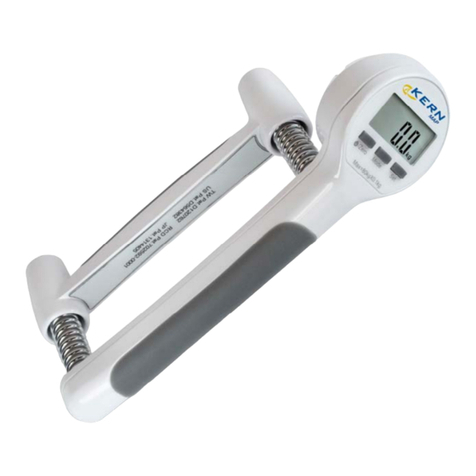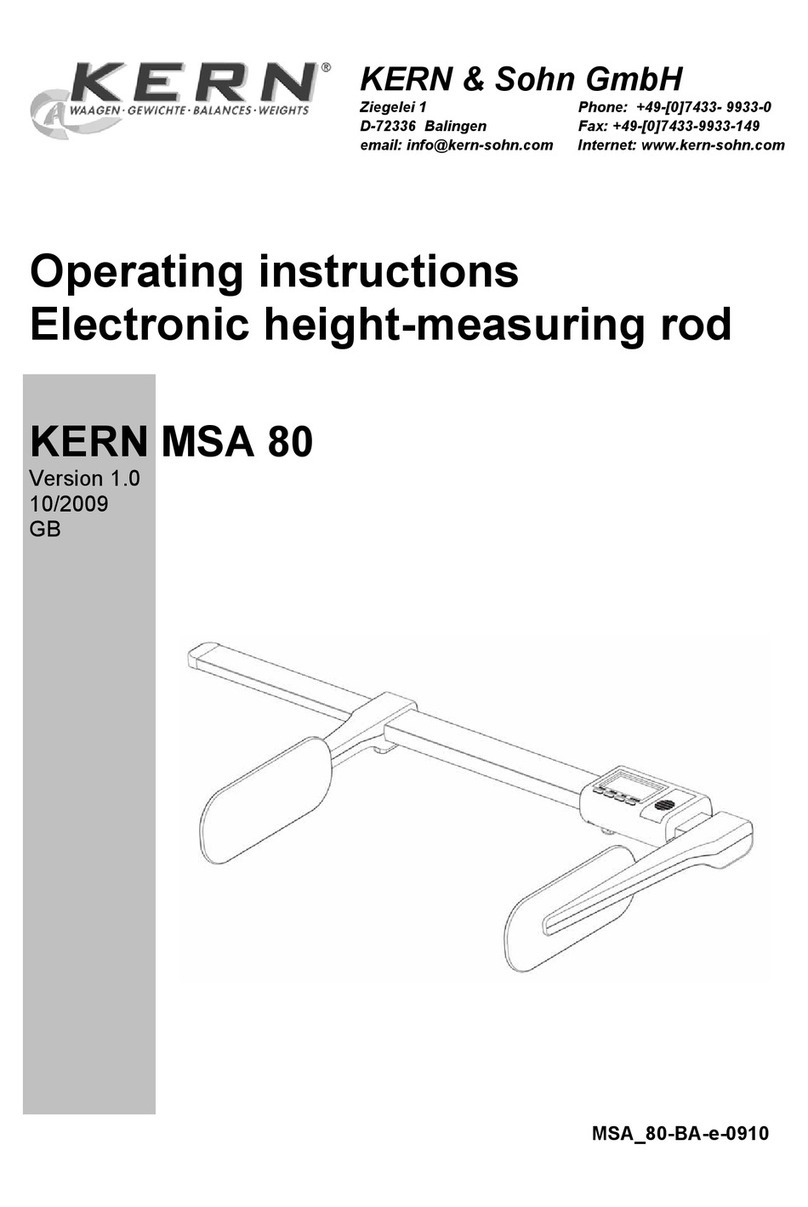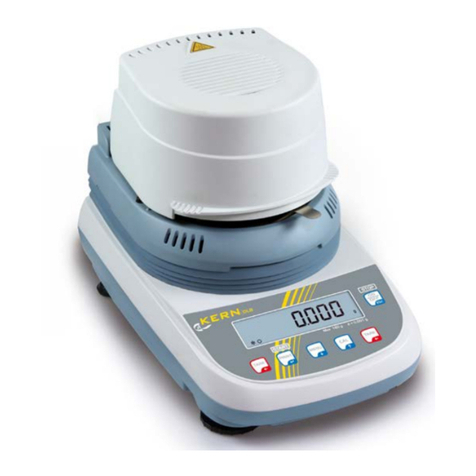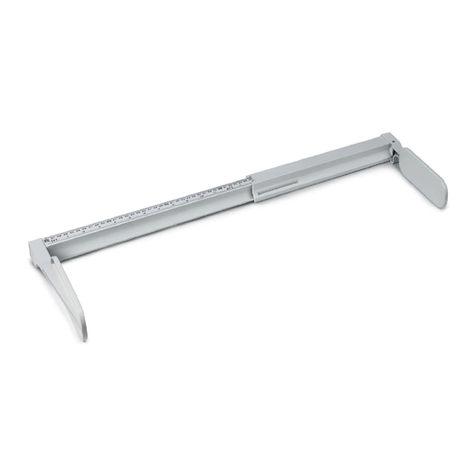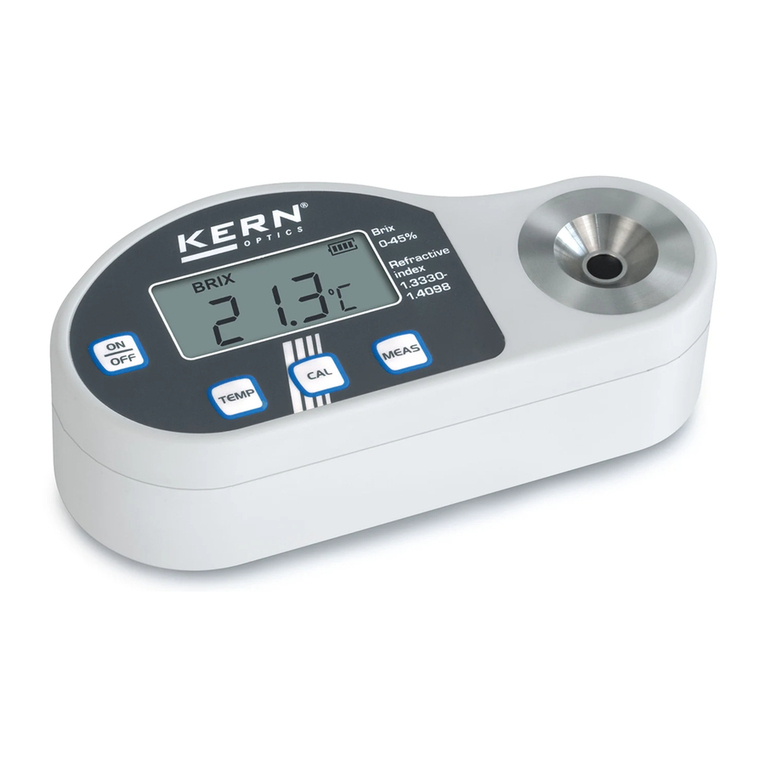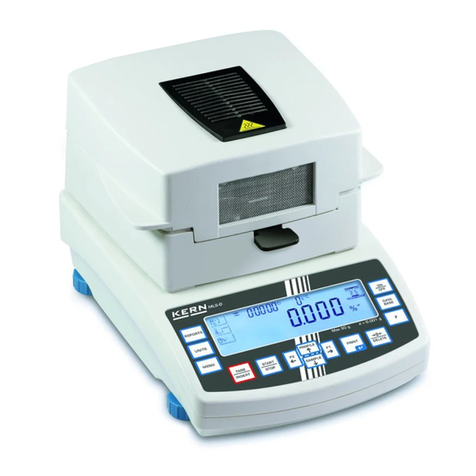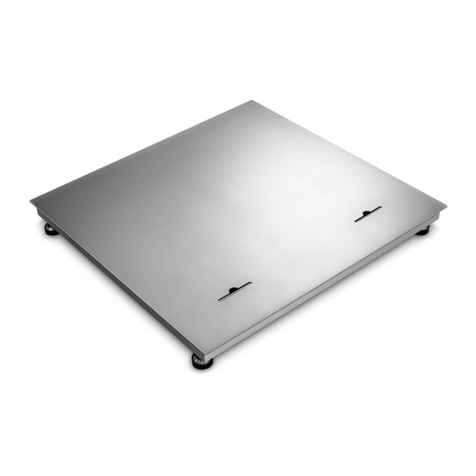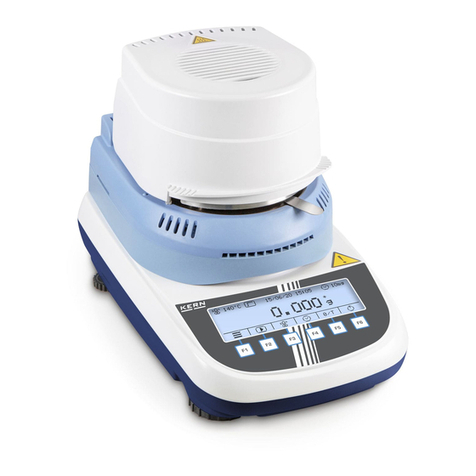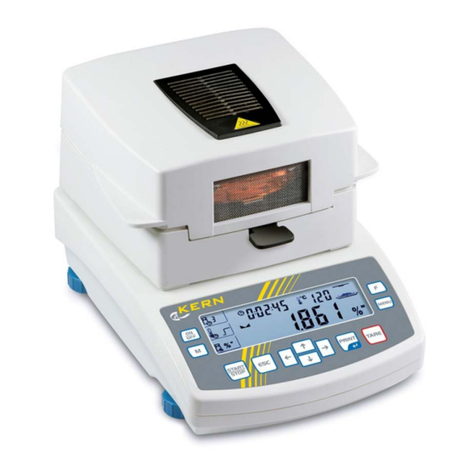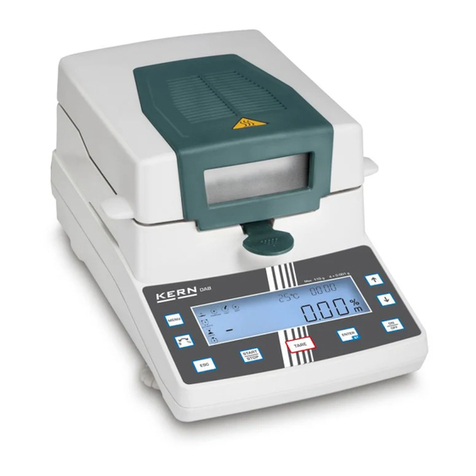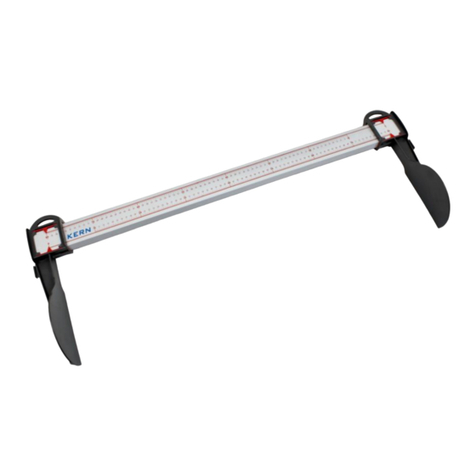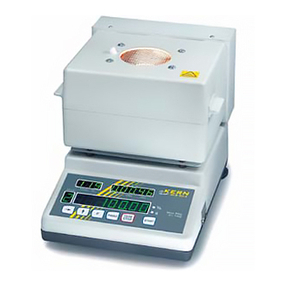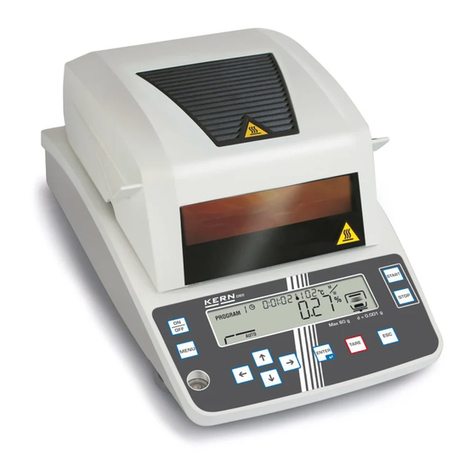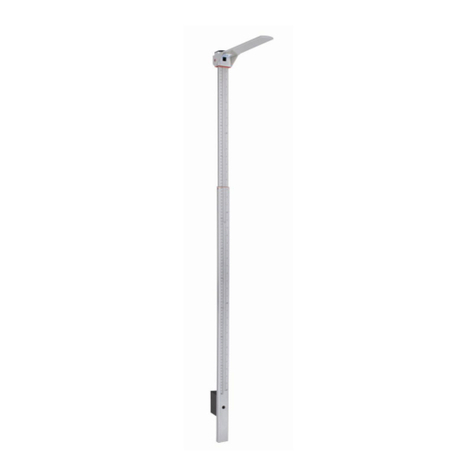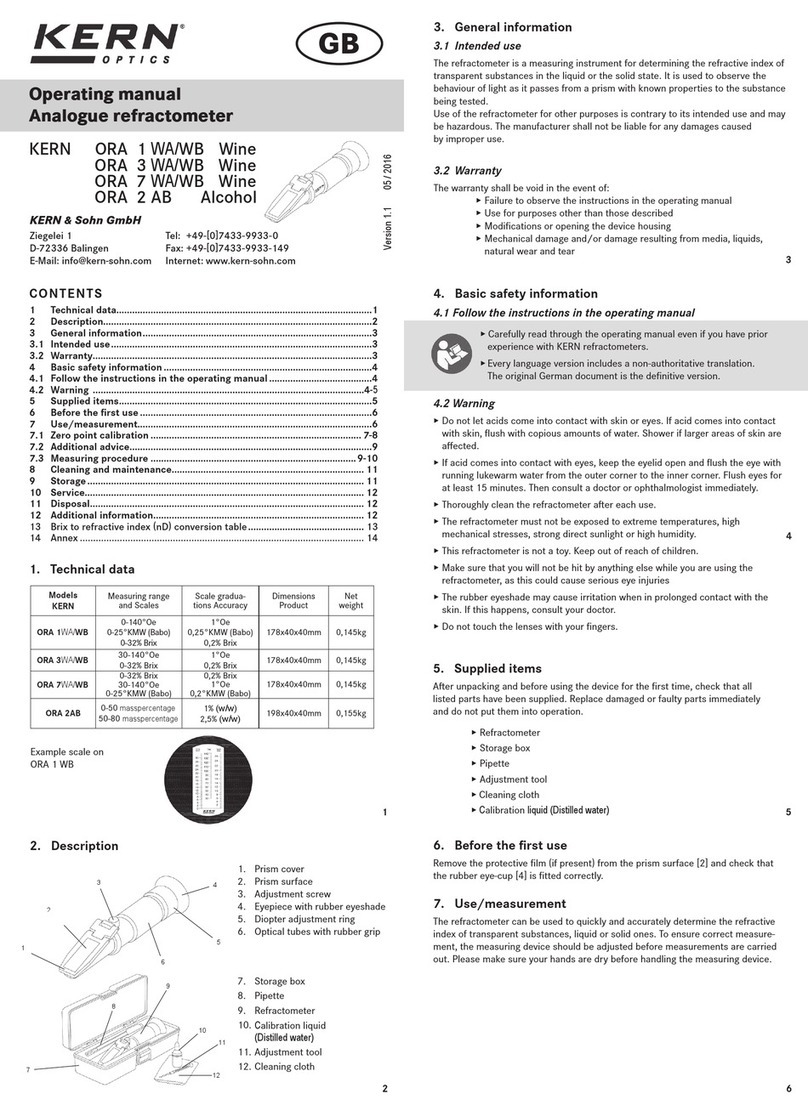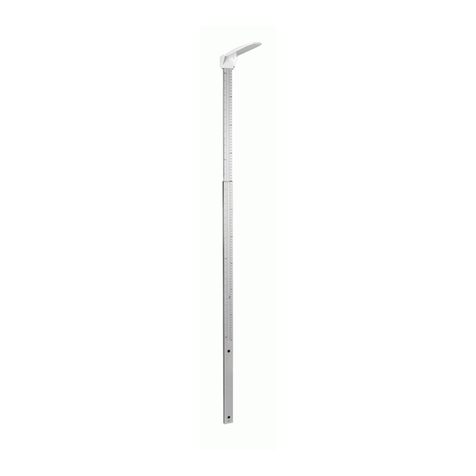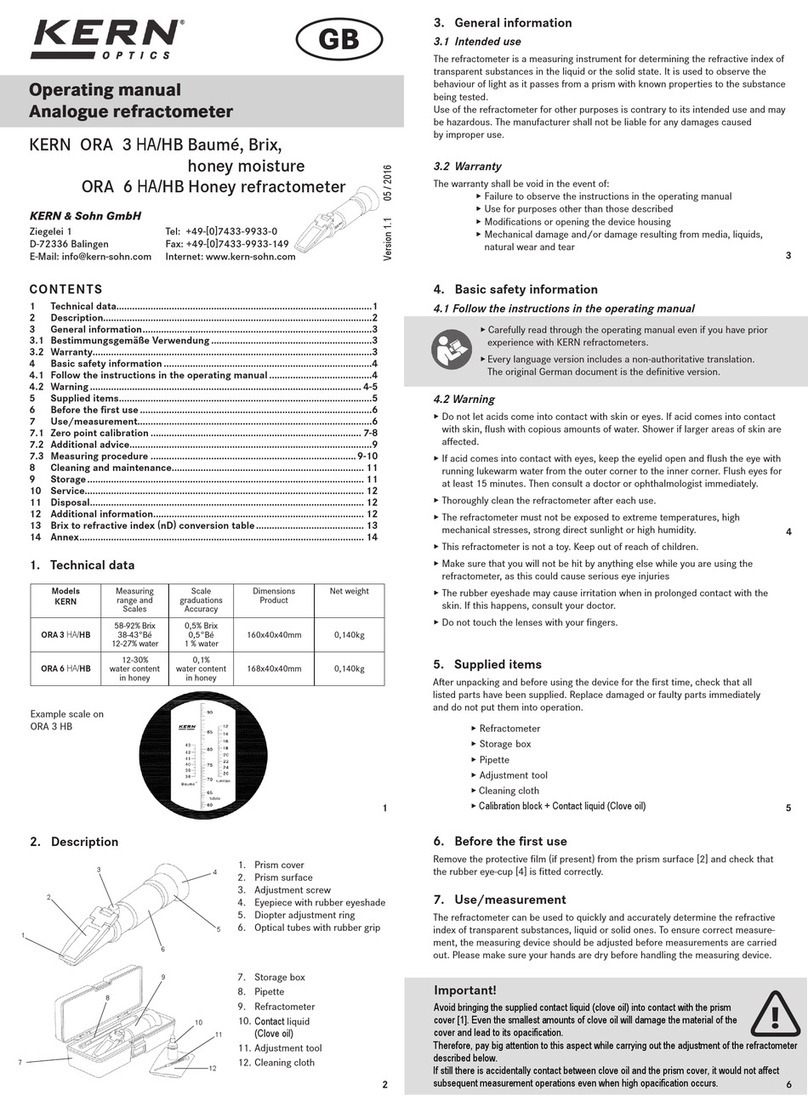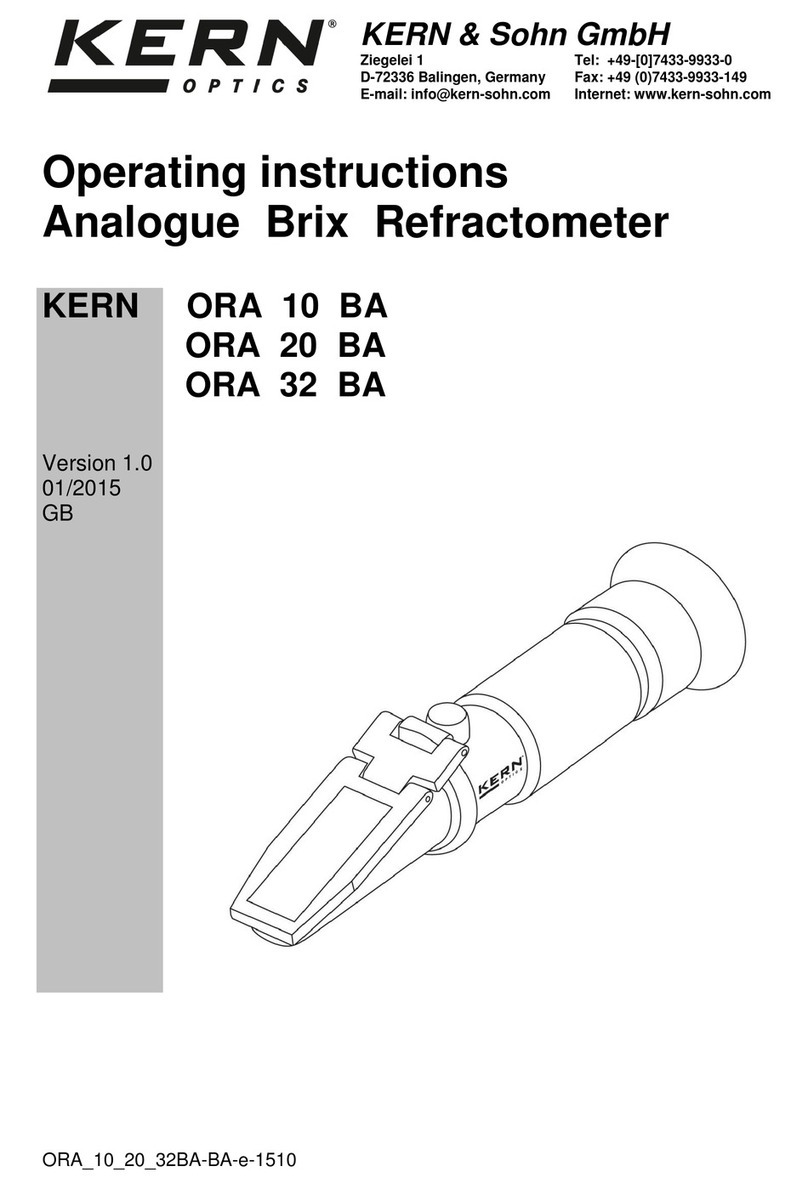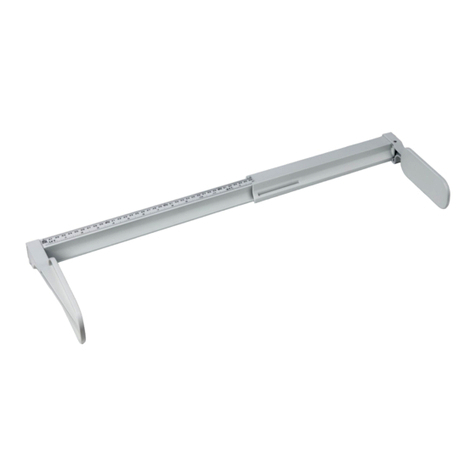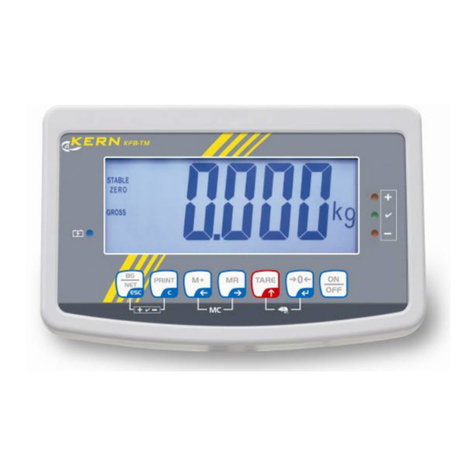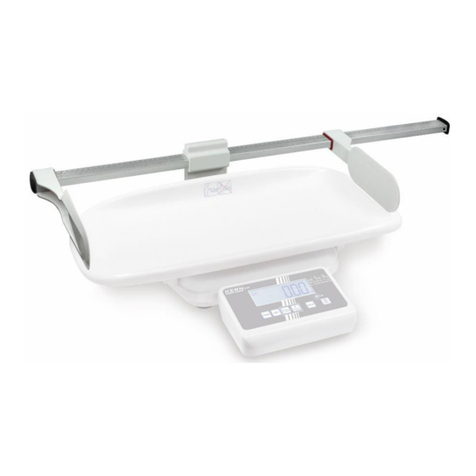
15 ORD-BA-e-1510
Data from "ICUMSA" International Commission for Uniform Methods
of Sugar Analysis, at 20 °C and 589 nm wavelength.
19. Brix to refractive index (nD) conversion table
Data from „ICUMSA“ International Commission for Uniform Methods
of Sugar Analysis, at 20 °C and 589 nm wavelength.
14. Cleaning and maintenance
Clean the refractometer using a so, lint-free cloth moistened with water, or if
necessary alcohol. Do not use any aggressive or abrasive cleaning agents. Never
immerse the device in water or hold it under running water. Never handle the
device with wet or damp hands.
Never touch the measuring prism [2]with hard tools made from plastic, wood,
rubber, metal, glass etc. Hard objects can quickly damage the relatively so
prism glass, re-sulting in measurement errors.
The refractometer is maintenance-free.
Cleaning should be carried out immediately before and aer each use of the
refractometer to maximise its life and optimise measurement results.
15. Storage
Store the refractometer in a dry, non-corrosive environment, preferably between
10 °C and 30 °C.
16. Service
Aer reading this operating manual, if you have any questions about setting up
or using the refractometer, or if any unexpected problem occurs, please contact
your dealer. The device housing may only be opened by trained service
technicians authorised by KERN.
17. Disposal
The packaging consists of environmentally friendly materials which can be
disposed of via local recycling facilities.
The device and storage box should be disposed of by the operator in accordance
with applicable national or regional regulations at the place of use.
18. Additional information
The product may differ slightly from the illustrations.
The exposing the refractometer to direct sunlight!
Never bring the refractometer into contact with solvents.
9
13. Troubleshooting
If you suspect that the measuring instrument is not working correctly or displays
incorrect results, perform a zero point calibration. Then perform a measurement
using water to check the zero point. If the measured data still appear untrustwor-
thy, please replace the batteries and perform the above calibration once again.
If the measuring instrument jams or no longer reacts, separate the measuring
instrument from the power supply by removing the batteries and replacing them.
If no data appears in the display when it is switched on, examine the position and
polarity of the batteries. If the instrument still does not work, please examine the
battery charge status and/or replace the batteries. If the batteries are good and
the measuring instrument still does not display, please call your dealer‘s technical
customer service.
11. Switching the temperature
The measuring instrument is multifunctional. A variety of measuring scales can be
used.
ORA-BA-d-1410 10
9Messung
1. Das Prismen Fenster [3] überprüfen damit dieses sauber und trocken ist.
2. Geben Sie ein paar Tropfen der zu prüfenden Flüssigkeit auf das Prismen
Fenster
3. Die Taste „Meas“ drücken, dann wird das Instrument anfangen zu messen.
4. Sie können die Taste „Meas“ erneut drücken und wieder loslassen, somit wird
eine zweite Messung durchgeführt. Denken Sie daran, das Prisma nach der
Messung zu reinigen und zu trocknen.
10 Batterie Wechsel
Bei voller Batterie erscheint im Display oben links das Symbol “ „
Ist die Batterie zu schwach oder fast leer, dann erscheint oben rechts
das Symbol „ “. Dann sollte die Batterie erneuert werden. Dazu den Batterie De-
ckel auf der Rückseite öffnen und die Batterien erneuern. Immer beide Batterien er-
neuern!
11 Umschalten der Temperatur Skala
Das Messgerät arbeitet in Grad Celsius oder Grad Fahrenheit. Für das Umschalten
einfach die Taste „Temp“ [5] drücken
12. Switching the measuring scale
The measuring instrument is multifunctional. A variety of measuring scales can be
used.
11 ORD-BA-d-1410
12 Umschalten der Messskala
Das Messgerät ist Multifunktional. Verschiedene Messskalen können verwendet
werden.
1. Versichern Sie sich, dass das Refraktometer sich im Temperatur Status
befindet:
2. Drücken Sie gleichzeitig die Taste „Cal“ [6] und die Taste „Meas“ [7]. Das
Messgerät wird die Messskala wechseln:
3. Wenn die gewünschte Messskala erscheint beide Tasten wieder loslassen.
Die Einstellung ist beendet
13 Fehlerdiagnose
Wenn Sie vermuten, daß das Messgerät nicht richtig arbeitet oder falsch anzeigt
dann machen Sie bitte eine Nullpunkt Justierung. Machen Sie danach eine Messung
mit Wasser zur Überprüfung des Nullpunktes. Sind die Messwerte danach immer
noch nicht vertrauenswürdig dann ersetzten Sie bitte die Batterie und machen Sie
erneut den obigen Abgleich. Wenn das Messgerät blockiert oder nicht mehr reagiert,
dann trennen Sie das Messgerät von der Stromversorgung indem Sie die Batterie
herausnehmen und wieder einsetzten. Falls beim Einschalten keine Werte im Display
erscheinen, dann prüfen Sie bitte die Position und Polarität der Batterien. Sollte das
Gerät immer noch nicht arbeiten dann prüfen Sie bitte den Ladezustand der Batterien
und oder ersetzten Sie die Batterien. Wenn die Batterien gut sind und das Messgerät
immer noch nichts anzeigt, dann rufen Sie bitte den technischen Kundendienst Ihres
Händlers.
2. Simultaneously press the ‚Cal‘ [6]and the ‚Meas‘ [7]buttons.
The measuring instrument will change the measuring scale:
11 ORD-BA-d-1410
12 Umschalten der Messskala
Das Messgerät ist Multifunktional. Verschiedene Messskalen können verwendet
werden.
1. Versichern Sie sich, dass das Refraktometer sich im Temperatur Status
befindet:
2. Drücken Sie gleichzeitig die Taste „Cal“ [6] und die Taste „Meas“ [7]. Das
Messgerät wird die Messskala wechseln:
3. Wenn die gewünschte Messskala erscheint beide Tasten wieder loslassen.
Die Einstellung ist beendet
13 Fehlerdiagnose
Wenn Sie vermuten, daß das Messgerät nicht richtig arbeitet oder falsch anzeigt
dann machen Sie bitte eine Nullpunkt Justierung. Machen Sie danach eine Messung
mit Wasser zur Überprüfung des Nullpunktes. Sind die Messwerte danach immer
noch nicht vertrauenswürdig dann ersetzten Sie bitte die Batterie und machen Sie
erneut den obigen Abgleich. Wenn das Messgerät blockiert oder nicht mehr reagiert,
dann trennen Sie das Messgerät von der Stromversorgung indem Sie die Batterie
herausnehmen und wieder einsetzten. Falls beim Einschalten keine Werte im Display
erscheinen, dann prüfen Sie bitte die Position und Polarität der Batterien. Sollte das
Gerät immer noch nicht arbeiten dann prüfen Sie bitte den Ladezustand der Batterien
und oder ersetzten Sie die Batterien. Wenn die Batterien gut sind und das Messgerät
immer noch nichts anzeigt, dann rufen Sie bitte den technischen Kundendienst Ihres
Händlers.
3. When the required measuring scale appears release the buttons again.
Adjustment is complete
9. Measuring*
1. Inspect the prism window [3]to ensure it is clean and dry.
2. Apply a few drops of the liquid being examined onto the prism window.
3. Press the ‚Meas‘ button; the instrument begins to measure.
ORA-BA-e-1510 10
2. Apply a few drops of the liquid being examined onto the prism window.
3. Press the 'Meas' button; the instrument begins to measure.
4. You may press the 'Meas' button again and then release it; a second meas-
urement is then performed. Remember to clean and dry the prism after mea-
suring.
10 Battery replacement
When the batteries are fully charged the ' ' symbol appears at the top left of the
display.
If the batteries are too weak or almost drained the
' ' symbol appears at the top right. The batteries should then be replaced. Open
the battery cover on the rear and replace the batteries. Always replace both batteries!
11 Switching the temperature
The measuring instrument works with either degrees Celsius or degrees Fahrenheit.
To switch, simply press the 'Temp' button [5].
12 Switching the measuring scale
The measuring instrument is multifunctional. A variety of measuring scales can be
used.
1. Ensure that the refractometer is in temperature
4. You may press the ‚Meas‘ button again and then release it; a second measurement is
then performed. Remember to clean and dry the prism aer measuring.
13.1 Error messages
ORA-BA-d-1410 12
13.1 Fehler Meldungen
Justierung außerhalb des Messbereiches (Null Punkt)
Batterie leer
Temperatur für das Messgerät zu niedrig (0 °C)
Temperatur für das Messgerät zu hoch (40 °C)
Temperatur für das Messgerät zu niedrig (32 °F)
Temperatur für das Messgerät zu hoch (104 °F)
Messung außerhalb des Messbereichs
am unteren Ende der Skala.
Adjustment outside of measuring range (zero point).
ORA-BA-d-1410 12
13.1 Fehler Meldungen
Justierung außerhalb des Messbereiches (Null Punkt)
Batterie leer
Temperatur für das Messgerät zu niedrig (0 °C)
Temperatur für das Messgerät zu hoch (40 °C)
Temperatur für das Messgerät zu niedrig (32 °F)
Temperatur für das Messgerät zu hoch (104 °F)
Messung außerhalb des Messbereichs
am unteren Ende der Skala.
ORA-BA-d-1410 12
13.1 Fehler Meldungen
Justierung außerhalb des Messbereiches (Null Punkt)
Batterie leer
Temperatur für das Messgerät zu niedrig (0 °C)
Temperatur für das Messgerät zu hoch (40 °C)
Temperatur für das Messgerät zu niedrig (32 °F)
Temperatur für das Messgerät zu hoch (104 °F)
Messung außerhalb des Messbereichs
am unteren Ende der Skala.
Temperature too low for measuring instrument (0 °C)
ORA-BA-d-1410 12
13.1 Fehler Meldungen
Justierung außerhalb des Messbereiches (Null Punkt)
Batterie leer
Temperatur für das Messgerät zu niedrig (0 °C)
Temperatur für das Messgerät zu hoch (40 °C)
Temperatur für das Messgerät zu niedrig (32 °F)
Temperatur für das Messgerät zu hoch (104 °F)
Messung außerhalb des Messbereichs
am unteren Ende der Skala.
Temperature too high for measuring instrument (40 °C)
ORA-BA-d-1410 12
13.1 Fehler Meldungen
Justierung außerhalb des Messbereiches (Null Punkt)
Batterie leer
Temperatur für das Messgerät zu niedrig (0 °C)
Temperatur für das Messgerät zu hoch (40 °C)
Temperatur für das Messgerät zu niedrig (32 °F)
Temperatur für das Messgerät zu hoch (104 °F)
Messung außerhalb des Messbereichs
am unteren Ende der Skala.
Temperature too low for measuring instrument (32 °F)
ORA-BA-d-1410 12
13.1 Fehler Meldungen
Justierung außerhalb des Messbereiches (Null Punkt)
Batterie leer
Temperatur für das Messgerät zu niedrig (0 °C)
Temperatur für das Messgerät zu hoch (40 °C)
Temperatur für das Messgerät zu niedrig (32 °F)
Temperatur für das Messgerät zu hoch (104 °F)
Messung außerhalb des Messbereichs
am unteren Ende der Skala.
Temperature too high for measuring instrument (104 °F)
ORA-BA-d-1410 12
13.1 Fehler Meldungen
Justierung außerhalb des Messbereiches (Null Punkt)
Batterie leer
Temperatur für das Messgerät zu niedrig (0 °C)
Temperatur für das Messgerät zu hoch (40 °C)
Temperatur für das Messgerät zu niedrig (32 °F)
Temperatur für das Messgerät zu hoch (104 °F)
Messung außerhalb des Messbereichs
am unteren Ende der Skala.
Measurement outside of measuring range at bottom of scale.
13 ORD-BA-d-1410
Messung außerhalb des Messbereichs
am oberen Ende der Skala.
Messung außerhalb des Messbereichs
am unteren Ende der Skala.
Messung außerhalb des Messbereichs
am oberen Ende der Skala.
Kalibrierflüssigkeit außerhalb des Messbereichs
Measurement outside of measuring range at top of scale.
13 ORD-BA-d-1410
Messung außerhalb des Messbereichs
am oberen Ende der Skala.
Messung außerhalb des Messbereichs
am unteren Ende der Skala.
Messung außerhalb des Messbereichs
am oberen Ende der Skala.
Kalibrierflüssigkeit außerhalb des Messbereichs
Measurement outside of measuring range at bottom of scale.
13 ORD-BA-d-1410
Messung außerhalb des Messbereichs
am oberen Ende der Skala.
Messung außerhalb des Messbereichs
am unteren Ende der Skala.
Messung außerhalb des Messbereichs
am oberen Ende der Skala.
Kalibrierflüssigkeit außerhalb des Messbereichs
Measurement outside of measuring range at top of scale.
13 ORD-BA-d-1410
Messung außerhalb des Messbereichs
am oberen Ende der Skala.
Messung außerhalb des Messbereichs
am unteren Ende der Skala.
Messung außerhalb des Messbereichs
am oberen Ende der Skala.
Kalibrierflüssigkeit außerhalb des Messbereichs
Calibration liquid outside of measuring range
10. Battery change
When the batteries are fully charged the “ „ symbol appears at the top
le of the display.
If the batteries are too weak or almost drained the „ “symbol appears at
the top right. The batteries should then be replaced. Open the battery cover on
the rear and replace the batteries. Always replace both batteries!
temperature compensation ensures accurate measurement results for water-based
solutions in relation to the temperature of the sample.
The refractometer is temperature-compensated for water-based, sugary solutions.
Temperature differences in a range of 10 °C–30 °C (50 °F–86 °F) can be compensated.
However, the temperature of the sample has only a minor influence on the accuracy of
the measurement. The volume of the sample compared to the mass of the refractometer
is so small that in moat cases the sample is almost immediately at the temperature of
the refractometer and assumes the ambient temperature, and is therefore in equilibrium
with the temperature range of the measuring instrument. The temperature coefficient of
the majority of water-based solutions is generally very close to the coefficient of the
cane sugar/water solution. However, the temperature coefficient of oils, hydrocarbons
and other, non-water-based solutions is generally greater. In order to achieve as
accurate a result as possible, non-water based samples should be measured at an
ambient temperature as close to 20 °C (68 °F) as possible.
8. Calibration/zero point calibration
The refractometer‘s zero position must be inspected prior to initial use and periodically
thereaer. A zero point calibration should be performed at least once daily and prior to
any measurement where the highest possible accuracy is required, or when moving to a
different environment with a different ambient temperature. For the majority of models all
you need for calibration/zero point calibration is distilled and deionised water. Ideally, the
ambient and calibration liquid temperature should be between 10 °C and 30 °C (50 °F–86
°F) during calibration.
Calibration liquid with 60% Brix is required for a variety of models.
You should be aware of the adjustment condition when using a measuring
instrument.
1. Inspect the prism to ensure that the surface is clean and dry.
2. Apply a few drops of the calibration liquid onto the prism window.
3. Press the CAL button [6]for five seconds; the measuring instrument begins the zero
point calibration process.
9 ORD-BA-e-1510
8Calibration/zero point calibration
The refractometer's zero position must be inspected prior to initial use and periodical-
ly thereafter. A zero point calibration should be performed at least once daily and pri-
or to any measurement where the highest possible accuracy is required, or when
moving to a different environment with a different ambient temperature. For the ma-
jority of models all you need for calibration/zero point calibration is distilled and de-
ionised water. Ideally, the ambient and calibration liquid temperature should be be-
tween 10 °C and 30 °C (50 °F–86 °F) during calibration.
Calibration liquid with 60% sugar is required for a variety of models.
You should be aware of the adjustment condition when using a measuring instru-
ment.
1. Inspect the prism to ensure that the surface is clean and dry.
2. Apply a few drops of the calibration liquid onto the prism window.
3. Press the CAL button [6] for five seconds; the measuring instrument begins
the zero point calibration process.
4. The measuring instrument is performing the calibration process when 'CAL3',
'CAL2', 'CAL1', 'CAL0' appear in the display.
5. When the calibration process is complete this is shown in the display
6. Calibration liquids vary, depending on the measuring range of the instrument.
9Measuring
1. Inspect the prism window [3] to ensure it is clean and dry.
4. The measuring instrument is performing the calibration process when ‚CAL3‘,
‚CAL2‘, ‚CAL1‘, ‚CAL0‘ appear in the display.
5. When the calibration process is complete this is shown in the display
6. Calibration liquids vary, depending on the measuring range of the instrument.
9 ORD-BA-e-1510
8Calibration/zero point calibration
The refractometer's zero position must be inspected prior to initial use and periodical-
ly thereafter. A zero point calibration should be performed at least once daily and pri-
or to any measurement where the highest possible accuracy is required, or when
moving to a different environment with a different ambient temperature. For the ma-
jority of models all you need for calibration/zero point calibration is distilled and de-
ionised water. Ideally, the ambient and calibration liquid temperature should be be-
tween 10 °C and 30 °C (50 °F–86 °F) during calibration.
Calibration liquid with 60% sugar is required for a variety of models.
You should be aware of the adjustment condition when using a measuring instru-
ment.
1. Inspect the prism to ensure that the surface is clean and dry.
2. Apply a few drops of the calibration liquid onto the prism window.
3. Press the CAL button [6] for five seconds; the measuring instrument begins
the zero point calibration process.
4. The measuring instrument is performing the calibration process when 'CAL3',
'CAL2', 'CAL1', 'CAL0' appear in the display.
5. When the calibration process is complete this is shown in the display
6. Calibration liquids vary, depending on the measuring range of the instrument.
9Measuring
1. Inspect the prism window [3] to ensure it is clean and dry.
BRIX RI BRIX RI BRIX RI
% nD % nD % nD
0 1,33299 30 1,38115 60 1,44193
1 1,33442 31 1,38296 61 1,44420
2 1,33586 32 1,38478 62 1,44650
3 1,33732 33 1,38661 63 1,44881
4 1,33879 34 1,38846 64 1,45113
5 1,34026 35 1,39032 65 1,45348
6 1,34175 36 1,39220 66 1,45584
7 1,34325 37 1,39409 67 1,45822
8 1,34476 38 1,39600 68 1,46061
9 1,34629 39 1,39792 69 1,46303
10 1,34782 40 1,39986 70 1,46546
11 1,34937 41 1,40181 71 1,46792
12 1,35093 42 1,40378 72 1,47037
13 1,35250 43 1,40576 73 1,47285
14 1,35408 44 1,40776 74 1,47535
15 1,35568 45 1,40978 75 1,47787
16 1,35729 46 1,41181 76 1,48040
17 1,35891 47 1,41385 77 1,48295
18 1,36054 48 1,41592 78 1,48552
19 1,36218 49 1,41799 79 1,4881
20 1,36384 50 1,42009 80 1,49071
21 1,36551 51 1,42220 81 1,49333
22 1,36720 52 1,42432 82 1,49597
23 1,36889 53 1,42647 83 1,49862
24 1,37060 54 1,42862 84 1,50129
25 1,37233 55 1,43080 85 1,50398
26 1,37406 56 1,43299
27 1,37582 57 1,43520
28 1,37758 58 1,43743
29 1,37936 59 1,43967
*Further information on Measuring
It is important to take care of the lighting conditions in the user
environment when calibrating the device and subsequent
measuring a sample.
The measuring prism of the refractometer does not have any
coverage and therefore a measurement in addition to the light of
the internal light source is also influenced by ambient light.
To bright lighting (eg., by a lamp directly above the device) may
trigger an error message already during the calibration. Ordinary
(diffuse) light is not a problem.
The lighting conditions (or the location of the device) may not be
changed after the calibration or between different measurements,
otherwise the refractometer performs each of the processes on a
different basis and the results would not be comparable.
We recommend that both for the calibrations and for
measurements, after the sample was placed on the measuring
prism, to create an improvised opaque cover over the prism (incl.
sample).
